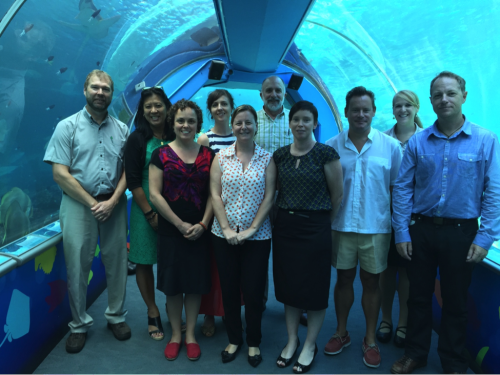Resilience based management of the Great Barrier Reef
Bill Dennison ·This is part one of a three-part series of blog posts about developing a reef resilience index for the Great Barrier Reef at a workshop in Townsville in March 2015.
'Resilience Based Management' was one of the concepts that arose during our workshop with resource managers at the Great Barrier Reef Marine Park Authority in Townsville, Australia on 2 Mar 2015. This shift in a focus toward managing for ecosystem resilience rather than managing for ecosystem condition takes into account the ability of the ecosystem to resistant disturbances and recover from those disturbances that affect the ecosystem, independent of the actual current status of the ecosystem.
We discussed a couple of international examples of tropical ecosystems that were in apparently good condition, but reached an ecological tipping point in which a relatively ephemeral stress resulted in a permanent phase shift to a different, less desirable status. One example was Jamaican coral reefs pre-1983 when coral cover was high, with strong fishing pressure and coastal eutrophication but the high abundance of spiny sea urchins (Diadema) grazing the algal components of the reef maintained the coral cover. A Caribbean-wide mass mortality of the sea urchins resulted in a rapid phase shift in the Jamaican reefs which became largely algal dominated with a massive loss in coral cover. In this case study, well documented by Terry Hughes and colleagues, simply monitoring coral cover would not predict the vulnerability of these reefs and would not trigger the management actions like regulating fisheries or reducing nutrient runoff that could have averted the ecological phase shift.

Another example from the Caribbean was Florida Bay, when a massive seagrass dieback led to an ecological cascade which included phytoplankton blooms, sponge mortalities and spiny lobster declines. Extensive seagrass meadows dominated by turtle grass (Thalassia testudinum) formed in the shallow 'gin-clear' waters of Florida Bay as a result of a) water diversions in South Florida that reduced freshwater flows across the Everglades and b) the relative lack of large seagrass grazers like green sea turtles and manatees due to historical fishing pressure. This largely monotypic seagrass meadow was disturbed by a period of high water temperatures and hyper-salinity, unleashing the ecological cascade to a less desirable ecological status. The seagrass dieback and associated phase shift resulted in an intense research program (and debate), the development of a monitoring program and provided additional impetus for a 're-plumbing' of South Florida to restore some of the natural freshwater flows through the Everglades.
Resilience Based Management requires a shift in monitoring strategies so that there is a proper accounting for those factors that provide ecological resilience. In the Jamaican case study, monitoring herbivorous fish, sea urchin density and water quality would be better resilience indicators than coral cover. In the Florida Bay case study, monitoring sea surface temperatures, salinities and seagrass grazing in the seagrass meadows would be better resilience indicators than seagrass biomass. The management approaches employed by Resilience Based Management would also be different. The importance of grazers in both case studies means that fisheries management needs to be integrated with water quality management. In addition, enhancing the recruitment potential of Jamaican corals and Florida Bay seagrasses would be warranted.

Our discussion led to the development of a 'Reef Health Matrix' in which both apparent reef condition and reef resilience are assessed. The matrix began as smiling/frowning faces, evolved to stoplight color coding to conceptual diagrams over the course of the workshop. For managing the Great Barrier Reef, this matrix integrates the reef Great Barrier Reef report card that regularly assesses the Reef Water Quality Protection Plan and the Reef Resilience Index which is being developed by scientists supported by the Great Barrier Reef Foundation. The 'Reef Health Matrix' also acknowledges that a reef may be in degraded conditions (e.g., post-cyclone damage or post-bleaching damage) but the outcome of this damage could range from an ephemeral impact to a permanent phase shift, depending on the resilience of the reef. This perspective provides a strong impetus for developing the Reef Resilience Index and integrating it with the Great Barrier Reef report card.
We were fortunate to have a good mix of strong academic perspectives (e.g., Peter Mumby, University of Queensland) and resource management perspectives (e.g., Roger Beeden, GBRMPA). Developing a Resilience Based Management approach will require the best minds of academia and resource management as we move forward. It was also a bonus to have this conversation immediately adjacent to the coral reef tank of Reef HQ and to be able to wander through the aquarium following our workshop.

About the author
Bill Dennison

Dr. Bill Dennison is a Professor of Marine Science and Vice President for Science Application at the University of Maryland Center for Environmental Science.

